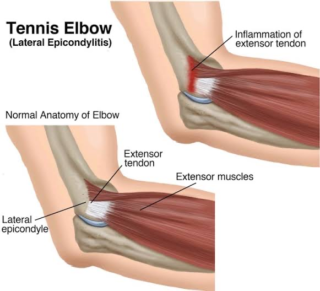CONDITIONS
Medical Conditions we treat:
HEAD
NECK
SHOULDER
WRIST
HIP
KNEE
ANKLE
BACK
ELBOW

Medical Conditions we treat:
- Musculoskeletal Conditions
Joints & Bones
Frozen Shoulder (Adhesive Capsulitis)
Bursitis
Dislocated Shoulder
Post Surgical Rehabilitation
Knee Pain
Osteoarthritis
Condramalacia Patella
Joint Stiffness
Neck & Spine
Neck Pain & Stiffness
Spondylitis
Low Back Pain
Sciatica
Degenerative Disc Disease(DDD)
Herniated Discs(Bulging Discs)/Slipped Disc
Spondylosis
Scoliosis
Piriformis Syndrome
Posture problems
Muscles
Spasm
Fibromyalgia
Rotator Cuff Injuries
De Quervain’s tenosynovitis
Trigger Finger
- Neurological conditions
- Sports injury conditions
Tennis Elbow
Lateral epicondylitis, commonly known as tennis elbow, is swelling of the tendons that bend your wrist backward away from your palm.
A tendon is a tough cord of tissue that connects muscles to bones. The tendon most likely involved in tennis elbow is called the extensor carpi radialis brevis. Tennis elbow is usually diagnosed in both men and women between the ages of 30 and 50 years.

Causes
Tennis elbow, as the name implies, is often caused by the force of the tennis racket hitting balls in the backhand position. Your forearm muscles, which attach to the outside of your elbow, may become sore from excessive strain. When making a backhand stroke in tennis, the tendons that roll over the end of our elbow can become damaged. Tennis elbow may be caused by:
- Improper backhand stroke
- Weak shoulder and wrist muscles
- Using a tennis racket that is too tightly strung or too short
- Other racquet sports, like racquetball or squash
- Hitting the ball off center on the racket, or hitting heavy, wet balls
However, many people who suffer from tennis elbow do not play tennis. The problem can be caused by any repetitive movement. Other causes of tennis elbow include:
- Painting with a brush or roller
- Operating a chain saw
- Frequent use of other hand tools on a regular basis
- Using repeated hand motions in various professions, such as meat cutters, musicians, dentists, and carpenters
Symptoms
The following are the most common symptoms of tennis elbow. However, you may experience symptoms differently.
At first, you may have pain, burning, or an ache along the outside of your forearm and elbow. With time, the pain gets worse. If you continue the activity that caused your condition, the pain may spread down to your wrist, even at rest. Pain may also persist when you place your arm and hand palm-down on a table, and then try to raise your hand against resistance. You may also feel pain when you try to lift and grip small objects, such as a coffee cup. A weak grip is another symptom of tennis elbow.
Diagnosis
Your healthcare provider can usually diagnosis your tennis elbow by a physical exam. In some cases, you may certain tests, such as:
An X-ray to look at the bones of your elbow to see if you have arthritis in your elbow.
Magnetic resonance imaging (MRI) can show your tendons and how severe the damage is. An MRI of your neck can show if arthritis in your neck, or disk problems in your spine are causing your arm pain.
Electromyography (EMG) of your elbow may show if you have any nerve problems that may be causing your pain.

